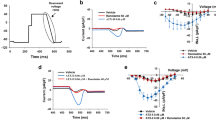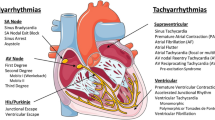Abstract
Aim:
To investigate the anti-arrhythmic effects of sulfamide analogues of changrolin and to characterize the sulfate of compound 6f (sulcardine sulfate, Sul) as a novel anti-arrhythmic agent.
Methods:
The anti-arrhythmic effects of compounds were studied against aconitine-induced arrhythmias in rats and ouabain-induced arrhythmias in guinea pigs. The effects of Sul on transmembrane action potentials were investigated in isolated rabbit sinoatrial nodes and guinea-pig papillary muscles using intracellular recording. With a whole-cell recording technique, the effects of Sul on sodium current, calcium current, and potassium currents were examined in isolated single guinea-pig ventricular myocytes.
Results:
In aconitine-induced arrhythmias of rats, sulfamide analogues of changrolin (4, 5, and 6a–6p) exhibited various anti-arrhythmic activities. The sulfate of compound 6f (Sul) increased the amount of aconitine required to induce arrhythmias in each treated animal. The ED50 value of Sul in rats was 196 mg/kg. In ouabain-induced arrhythmias of guinea pigs, 25, 50, and 100 mg/kg doses of Sul increased the dose of ouabain required to induce VP, VT, and VF in a dose-dependent manner. In papillary preparations, Sul produced a concentration-dependent decrease in APA and Vmax, prolonged APD90 and ERP, whereas RP was unaffected. In the spontaneously beating sinus nodes, Sul reduced APA and Vmax in a concentration-dependent manner. The whole-cell recording studies revealed that Sul produced a reversible reduction in INa (IC50=26.9 μmol/L) and ICa,L(IC50=69.2 μmol/L), whereas the inward rectifier (IK1) and the delayed rectifier potassium currents (IK) were unaffected.
Conclusion:
As a multi-ion channel blocker, Sul may have potent efficacy in anti-atrial and ventricular arrhythmias.
Similar content being viewed by others
Log in or create a free account to read this content
Gain free access to this article, as well as selected content from this journal and more on nature.com
or
References
Echt DS, Liebson PR, Mitchell LB, Peters RW, Obias-Manno D, Barker AH, et al. Mortality and morbidity in patients receiving encainide, flecainide, or placebo. The Cardiac Arrhythmia Suppression Trial. N Engl J Med 1991; 324: 781–8.
Nattel S, Carlsson L . Innovative approaches to anti-arrhythmic drug therapy. Nat Rev Drug Discov 2006; 5: 1034–49.
Walker MJA, So PPS . Anti-arrhythmics, In: Comprehensive Medicinal Chemistry II, Vol. 6 (Williams, M Ed). Amsterdam: Elsevier; 2007. p 729–62.
Li LQ, Qu ZX, Wang ZM, Zeng YL, Ding GS, Hu GJ, et al. Studies on a new antiarrhythmic drug changrolin — 4-(3′, 5′- bis(N-pyrrolidinylmethyl)-4′-hydroyanilino)quinazoline. Sci Sin 1979; 22: 1220–8.
Changrolin Coordination Research Group. Clinical observation on changrolin, an antiarrhythmic drug. Nat Med J Chin 1978; 58: 84–6.
Sun CJ, Zhang XY, Yang XZ, Wang PP, Shen J, Shu Y, et al. Studies on drugs for coronary diseases II. Synthesis of compounds related to changrolin as potential antiarrhythmic drugs. Yao Xue Xue Bao 1981; 16: 564–70.
Kang AL, Sun CJ . Studies on drugs for coronary diseases III. Synthesis of some Mannich lases of substituted aminophenols. Yao Xue Xue Bao 1986; 21: 892–8.
Chen WZ, Dong YL, Ding GS . Cardiovascular effect of a new antiarrhythmic drug — changrolin. Yao Xue Xue Bao 1979; 14: 710–4.
Stout DM, Matier WL, Barcelon-Yang C, Reynolds RD, Brown BS . Synthesis and antiarrhythmic and parasympatholytic properties of substituted phenols. 1. Heteroarylamine derivatives. J Med Chem 1983; 26: 808–13.
Stout DM, Matier WL, Barcelon-Yang C, Reynolds RD, Brown BS . Synthesis and antiarrhythmic and parasympatholytic properties of substituted phenols. 2. Amides. J Med Chem 1984; 27: 1347–50.
Stout DM, Matier WL, Barcelon-Yang C, Reynolds RD, Brown BS . Synthesis and antiarrhythmic and parasympatholytic properties of substituted phenols. 3. Modification of the linkage region. J Med Chem 1985; 28: 295–8.
Stout DM, Black LA, Barcelon-Yang C, Matier WL, Brown BS, Quon CY, et al. Ester derivatives of 2,6-bis(1-pyrrolidinylmethyl)-4-benzamidophenol as short-acting antiarrhythmic agents 1. J Med Chem 1989; 32: 1910–3.
Chorvat RJ, Black LA, Ranade VV, Barcelon-Yang C, Stout DM, Brown BS, et al. Mono- and bis(aminomethyl)phenylacetic acid esters as short-acting antiarrhythmic agents 2. J Med Chem 1993; 36: 2494–8.
Bo YX . The preparation of changrolin analogs [dissertation]. Shanghai Institute of Materia Medica, Chinese Academy of Sciences; 1991.
Chen WZ, Dong YL, Zhang YF, Ding GS . Antiarrhythmic effects of guan-fu base A. Zhongguo Yao Li Xue Bao 1983; 4: 247–50.
Dong YL, Chen WZ . Effects of guan-fu base A on experimental cardiac arrhythmia and myocardial contractility. Yao Xue Xue Bao 1995; 30: 577–82.
Kuang Y, Liu TP . Rate-dependent depression of maximal rate of depolarization in guinea pig papillary muscle action potentials by changrolin. Zhongguo Yao Li Xue Bao 1990; 11: 225–9.
Farmer BB, Mancina M, Williams ES, Watanabe AM . Isolation of calcium tolerant myocytes from adult rat heart: review of the literature and description of a method. Life Sci 1983; 33: 1–18.
Wang W, Hu GY, Wang YP . Selective modulation of L-type calcium current by magnesium lithospermate B in guinea-pig ventricular myocytes. Life Sci 2006; 78: 2989–97.
Wang W . Electrophysiological characterization of new cardiovascularly active compounds and cholinesterase inhibitors in guinea-pig heart [dissertation]. Shanghai Institute of Materia Medica, Chinese Academy of Sciences; 2005.
Acknowledgements
This work was supported by a grant from the Shanghai Committee of Science and Technology, China (No 975419000-4), and the Ministry of Science and Technology of China (Nos 2002AA2Z3123, 2005AA2Z3D60, and 2008ZX09101-004).
This paper is dedicated to the 80th anniversary of the founding of Shanghai Institute of Materia Medica, Chinese Academy of Sciences.
Author information
Authors and Affiliations
Corresponding authors
Additional information
Supplementary information (IR spectra and elemental analysis data for all new compounds) are available at website of Acta Pharmacologica Sinica on NPG.
Supplementary information
Appendix
Data of the IR spectra and elemental analysis of all new compounds. (DOC 120 kb)
Rights and permissions
About this article
Cite this article
Bai, Dl., Chen, Wz., Bo, Yx. et al. Discovery of N-(3,5-bis(1-pyrrolidylmethyl)-4-hydroxybenzyl)-4-methoxybenzenesulfamide (sulcardine) as a novel anti-arrhythmic agent. Acta Pharmacol Sin 33, 1176–1186 (2012). https://doi.org/10.1038/aps.2012.119
Received:
Accepted:
Published:
Issue date:
DOI: https://doi.org/10.1038/aps.2012.119
Keywords
This article is cited by
-
RETRACTED ARTICLE: Characterization of Preclinical Pharmacokinetic Properties and Prediction of Human PK Using a Physiologically Based Pharmacokinetic Model for a Novel Anti-Arrhythmic Agent Sulcardine Sulfate
Pharmaceutical Research (2021)
-
Barbaloin inhibits ventricular arrhythmias in rabbits by modulating voltage-gated ion channels
Acta Pharmacologica Sinica (2018)
-
Multiple Dose Pharmacokinetics and Safety of Sulcardine Sulfate in Healthy Chinese Male Subjects: An Open-Label Phase I Clinical Study
European Journal of Drug Metabolism and Pharmacokinetics (2017)
-
Oral Bioavailability and Mass Balance Studies of a Novel Anti-arrhythmic Agent Sulcardine Sulfate in Sprague–Dawley Rats and Beagle Dogs
European Journal of Drug Metabolism and Pharmacokinetics (2017)
-
Celebrating the 80th anniversary of the Shanghai Institute of Materia Medica, Chinese Academy of Sciences (SIMM)
Acta Pharmacologica Sinica (2012)



